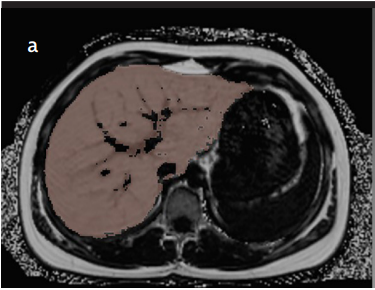Background/Aims: Proton density fat fraction (PDFF) magnetic resonance (MR) imaging can be a useful technique for volumetric measurements of liver fat. The purpose of our study was to evaluate the correlation between liver fat fraction (LFF) and aspartate aminotransferase (AST) and alanine aminotransferase (ALT) levels in children who are overweight and obese.
Materials and Methods: Overall, 25 children, aged 9-17 years, were included. Patients with a body mass index (BMI) z-score between 85-95th percentile (12 of 25 patients) were assigned to the overweight group, and those with BMI z-score above 95th percentile (13 of 25 patients) were assigned to the obese group. The control group comprised 12 healthy children with BMI z-score below 85th percentile. Liver fat fraction measurements were performed on 3D volume measurement workstation by using PDFF magnetic resonance (MR) images. Spearman’s correlation coefficients between liver fat fraction and AST and ALT levels were evaluated individually for overweight, obese, and control groups. Receiver operator characteristics (ROC) analysis was also performed.
Results: In the overweight and obese groups, the liver proton density fat fraction and AST levels had a strong correlation (r=0.716, p<0.001). In addition, the LFF and ALT levels demonstrated a strong correlation (r=0.878, p<0.001). ROC analysis ascertained an optimal liver fat fraction threshold of 114 for predicting AST level (sensitivity=75%, specificity=89%). ROC analysis ascertained an optimal LFF threshold of 114 for predicting ALT level (sensitivity=80%, specificity=90%).
Conclusion: Our results indicate a strong correlation between LFF values and AST and ALT levels in children who are overweight and obese.
Cite this article as: Pirimoğlu B, Sade R, Polat G, İşlek A, Kantarcı M. Analysis of correlation between liver fat fraction and AST and ALT levels in overweight and obese children by using new magnetic resonance imaging technique. Turk J Gastroenterol 2020; 31(2): 156-62.




.png)
.png)
